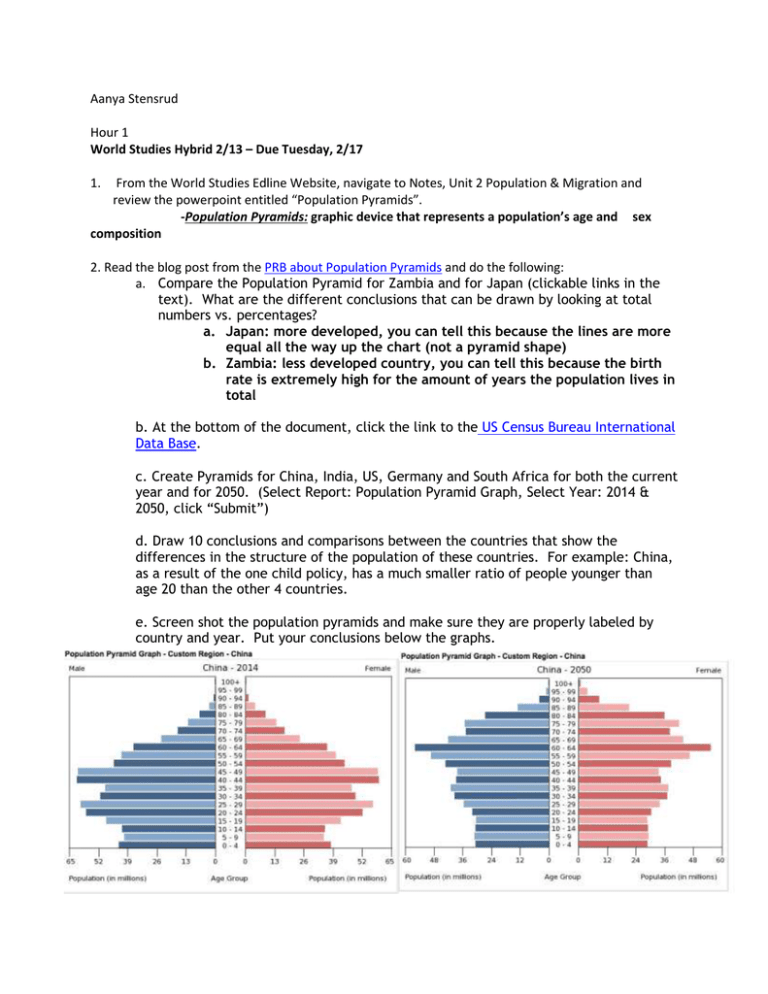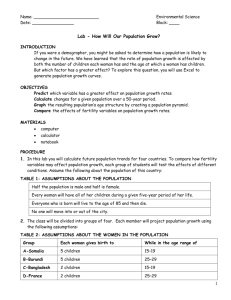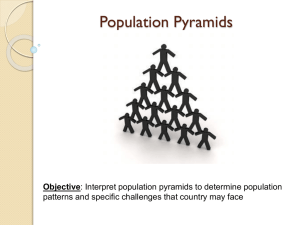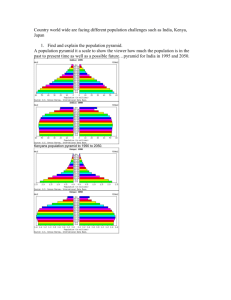File
advertisement

Aanya Stensrud Hour 1 World Studies Hybrid 2/13 – Due Tuesday, 2/17 1. From the World Studies Edline Website, navigate to Notes, Unit 2 Population & Migration and review the powerpoint entitled “Population Pyramids”. -Population Pyramids: graphic device that represents a population’s age and sex composition 2. Read the blog post from the PRB about Population Pyramids and do the following: a. Compare the Population Pyramid for Zambia and for Japan (clickable links in the text). What are the different conclusions that can be drawn by looking at total numbers vs. percentages? a. Japan: more developed, you can tell this because the lines are more equal all the way up the chart (not a pyramid shape) b. Zambia: less developed country, you can tell this because the birth rate is extremely high for the amount of years the population lives in total b. At the bottom of the document, click the link to the US Census Bureau International Data Base. c. Create Pyramids for China, India, US, Germany and South Africa for both the current year and for 2050. (Select Report: Population Pyramid Graph, Select Year: 2014 & 2050, click “Submit”) d. Draw 10 conclusions and comparisons between the countries that show the differences in the structure of the population of these countries. For example: China, as a result of the one child policy, has a much smaller ratio of people younger than age 20 than the other 4 countries. e. Screen shot the population pyramids and make sure they are properly labeled by country and year. Put your conclusions below the graphs. CHINA: -The amount of 40-49 year olds in China in 2014 had the most amount of people for their population. -The number of births in China in 2050 will decrease from the year of 2014. INDIA: -In 2014 in India, the graph shows a pyramid because the number of people who are being born is greater than the number of adults. -In India in 2050, the population’s overall age will stay at a constant rate until about age 60, when the number of elders decrease to the amount of younger kids. UNITED STATES: -The graph for 2014 stays at a pretty constant rate, not very pyramid shaped. -The graph changes in 2050 in the US because the number of people being born increase compared to 2014. GERMANY: -In 2014 in Germany, the graph is a diamond shape with the most popular and most amount of people at age 45-54. -In 2050, Germany’s population has a constant rate of births and around the same number of people from birth to age 85, when there gets to be a lot less. SOUTH AFRICA: -In 2014, South Africa’s population was a pyramid, meaning they are a less developed country. -In 2050, this issue decreases, but it is still an issue that South Africa isn’t as well developed as other countries in the world. 3. We watched the first segment of World in the Balance, a case study about India’s population (023:00). Describe the population issues India must address regarding high birth rates, status of women and poverty. What does their population pyramid tell you about what needs to be done in the future to support their population adequately? India has very high birth rates and they have troubles keeping up with the health of their children. The status of women is frowned upon. Women are less important than men and are forced to stay home working in the house and taking care of the kids. Poverty is still going to be a major problem unless India can decrease their birth rate, or get their medical technology to become more advanced. If the chart above is correct about India, their population is going to continue to grow. India will need to improve their medical inventions and also keep their poverty down in order for the population to be healthy. 4. Follow the link to: Lesson Plan: 2014 World Population Data Sheet. Complete Activity 1 (Questions 115), use the PRB Data Finder , charts and maps by topic, International section to view country rankings for each indicator. • What is the population of the world? 7,295,693,400 • Rank the ten countries with the largest population (from largest to smallest). China, India, United States, Indonesia, Brazil, Pakistan, Nigeria, Bangladesh, Russia, Japan • Instead of absolute numbers, rates are often used to tell how frequently a population or demographic event is occurring — rates show how common an event is. List the type of information on the data sheet reported by a rate. The amount of births recorded in a minute • The crude death rate (CDR) is the annual number of deaths per 1,000 population. Which country (or countries) has the highest CDR? Which country (or countries) has the lowest? South Africa (highest) Qatar (lowest) • The infant mortality rate measures the number of deaths each year to infants under one year of age per 1,000 live births. Which country (or countries) has the highest infant mortality rate and what is that rate? Which country (or countries) has the lowest and what is that rate? Afghanistan:136 deaths per 1000 births and Sweden: 3.4 deaths per 1000 births • The total fertility rate (TFR) is the average number of children women would have if they maintained the current level of childbearing throughout their reproductive years. Which countries (or countries) share the highest TFR and what is it? Which country (or countries) has the lowest TFR. What is it? Niger with the highest at (6.89) and Singapore with the lowest at (0.80) • Which country (or countries) has the "youngest" population, that is, the highest proportion of population under age 15? Which country (or countries) has the "oldest" population, that is, the highest proportion of population over age 64? Youngest: at 52%… Niger Oldest: at 28.7%… Monaco • In which country (or countries) are people expected to live the longest? Which country (or countries) has the lowest life expectancy? Japan (overall 84.6 years old) and Sierra Leone (overall 38 years old) • In which African country (or countries) does the highest proportion of people live in urban areas? In Asia? In Latin America? In Europe? In Oceania? • Gross national income in purchasing power parity per capita (GNI PPP) converts income into "international dollars" and indicates the amount of goods and services one could buy in the United States with a given amount of money. Which country (or countries) is the wealthiest in terms of GNI PPP? Which is the second wealthiest? 1st: Norway 2nd: Luxembourg • A population grows because there are more births than deaths or more people are moving in than moving out. The difference between births and deaths is expressed as a percentage called the rate of natural increase. Which region is growing the fastest through natural increase? Which region is growing at the slowest rate? • A population projection is a computation of future changes in population numbers based on assumptions about future trends in fertility, mortality, and migration. Which categories on the data sheet are shown as projections? • Rank the 10 countries with the largest projected populations for both 2023 and 2050 (from largest to the smallest). Which country's (or countries') population is projected to drop out of the top 10 by 2050? Which country (or countries) is projected to be added to the top 10? Look back to the rankings for the current year. What are the major shifts in this ranking from now to 2050? • India- 2025 (1,351,801) 2050 (1,572,055) • • • • • • • • • China- 2025 (1,470,787) 2050 (1,462,058) United States- 2025 (346,822) 2050 (397,063) Pakistan- 2025 (250,981) 2050 (344,170) Indonesia- 2025 (272,911) 2050 (311,335) Nigeria- 2025 (202,957) 2050 (278,788) Bangladesh- 2025 (210,823) 2050 (265,432) Brazil- 2025 (218,980) 2050 (247,244) Dem. Rep. of the Congo- 2025 (114,876) 2050 (203,527) Ethiopia- 2025 (113,418) 2050 (186,452 • Rank the regions according to population size (from largest to the smallest). 1. Asia 2. Africa 3. North America 4. South America 5. Antarctica 6. Europe 7. Australia





